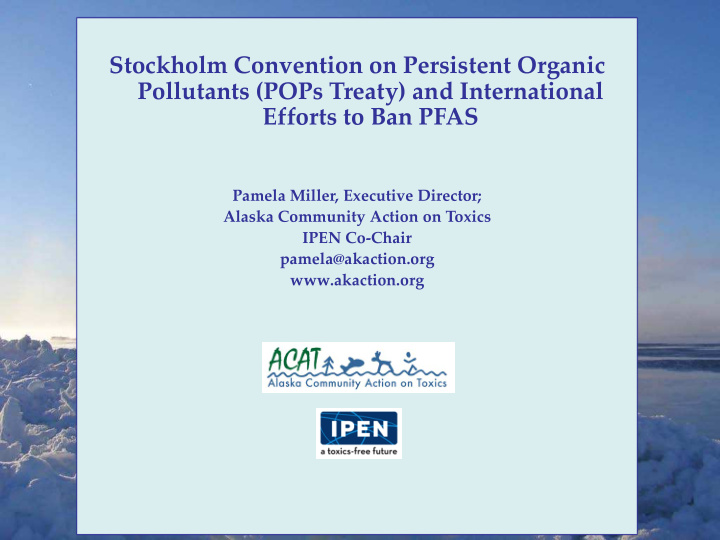



Stockholm Convention on Persistent Organic Pollutants (POPs Treaty) and International Efforts to Ban PFAS Pamela Miller, Executive Director; Alaska Community Action on Toxics IPEN Co-Chair pamela@akaction.org www.akaction.org
IPEN—Working for a Toxics-Free Future: A Network of Environmental Health, Justice, and Human Rights— 500 groups from 115 countries
Overview of U.N. Chemicals and Wastes Conventions Basel Convention —to address management, disposal, and transboundary movement of hazardous waste (entered into force in 1992) Rotterdam Convention —creates legally binding obligations for Prior Informed Consent Procedure (entered into force in 2004) Stockholm Convention —legally binding international agreement on persistent organic pollutants (entered into force in 2004; now 182 Parties)
The Language of the Stockholm Convention “Aware of the health concerns…in particular impacts upon women and children and, through them, upon future generations.” “Conscious of the need for global action …” “Acknowledging that precaution underlies the concerns of all the Parties and is embedded within this Convention…” “Determined to protect human health and the environment…” “Acknowledging that the Arctic ecosystems and Indigenous communities are particularly at risk.. .”
Key Elements of the Stockholm Convention Focus is on elimination rather than managing risk Ensure addition of new chemicals beyond initial list of twelve Identification and inventory of contaminated sites for clean up Effectiveness evaluation Based on the precautionary principle
New POPs—the POPS Review Committee (POPRC)
PFAS Chemicals and the Stockholm Convention PFOS listed in 2009 with exemptions and “acceptable purposes” POPRC recommended closing of major loopholes in 2018 PFOA nominated by the EU in 2015—POPRC made recommendation in September 2018 to list for global elimination and COP will make final decision in April 2019 PFHxS nominated by Norway in 2017—advanced to final stage of review in September 2018, Annex F
Independent expert panel convened by IPEN/ACAT “ The continued use of PFAS (per- and polyfluorinated substances) foams is not only unnecessary but would continue to add to the legacy and on-going contamination that is responsible for the substantial, widespread and growing socio- economic and environmental costs being experienced globally. ” www.ipen.org
Conclusions and Recommendations from the POPRC 2018 PFOA should be listed in Annex A for global elimination. PFHxS warrants global action and moves to the final stage of evaluation. Many PFOS loopholes in the current listing should be closed at the next Conference of the Parties (COP9) in April/May 2019. Firefighting foams containing PFOS and PFOA should be sharply restricted, (with time-limited specific exemptions for five years) and their fluorinated alternatives are not recommended. “A transition to the use of short-chain per- and polyfluoroalkyl substances (PFASs) for dispersive applications such as fire-fighting foams is not a suitable option from an environmental and human health point of view…” 10 time-limited exemptions are proposed for PFOA. Most are for 5 years, but some are for 10 – 18 years.
POPRC Recommendations on Firefighting Foams At POPRC14, the Committee recommended that governments at COP9 adopt the following restrictions on firefighting foams containing PFOA, PFOA-related substances, or PFOS: No production. Use for 5 years only for liquid fuel vapor suppression and liquid fuel fires (Class B fires) already in installed systems. No import or export, except for environmentally-sound disposal. No use for training or testing purposes. By 2022, restrict use to sites where all releases can be contained. Ensure that all firewater, wastewater, run-off, foam and other wastes are managed in accordance with the treaty.
Protecting the Health of Future Generations Engagement at the Stockholm Convention COP Conference of the Parties 29 April to 10 May 2019 in Geneva Decisions on PFOA, PFOS loopholes Join with international network of IPEN NGOs to influence these international decisions Action and engagement of community representatives affected by PFAS contamination—be the “conscience of the Convention”
Recommend
More recommend